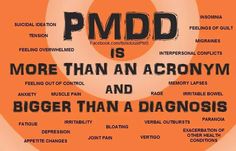PMDD Symptoms, Causes, & Treatments
By Joy Bing Fleming, MBA, CC
The International Association of Premenstrual Disorders (IAPMD) does a phenomenal job of explaining the ins and outs of PMDD. Many people (including medical professionals) are not familiar with it because PMDD only affects 2-10% of women during their reproductive age. I always like to mention that it is NOT the same as PMS. It has a different name because it is a different condition. PMS is much more common (as many as 80% of women experience some form of PMS during their reproductive years).
PMDD AWARENESS – World Health Organization – Click Here
The IAPMD posted the following: “In a landmark decision in May 2019, the World Health Organization (WHO) added Premenstrual Dysphoric Disorder (PMDD) to the International Statistical Classification of Diseases and Related Health Problems, Eleventh Revision (ICD-11). PMDD now has its own ICD code (GA34.41), validating PMDD as a legitimate medical diagnosis worldwide and acknowledging our growing scientific and medical understanding of this little known but debilitating condition.”
SYMPTOMS OF PMDD – Click Here and then scroll down the page CAUSES OF PMDD – Click Here and then scroll down the page TREATMENT OPTIONS FOR PMDD – Click Here and then scroll down the page
1 of the treatment options listed is oral contraceptives (OCPs/birth control pills); however, PLEASE BEWARE because the IAPMD also states that “…in some patients, these drugs may worsen dysphoria (a known side effect of some birth control pills) in many women with and without PMDD. The increase in symptoms seems to be especially prevalent in women with progesterone-sensitive type PMDD. Recent studies point to a direct link between the female hormone progesterone and PMDD. All OCPs contain progesterone and may make symptoms worse.“
That has been my personal experience as well. I have a sensitivity to Progesterone, and when I took birth control pills, they caused dysphoria. This ultimately led to me developing PMDD.
Another treatment option is SSRIs; however, PLEASE BEWARE that the IAPMD states that “Side effects can occur in up to 15% of women.” I am in that 15%, and my personal experience is that these side effects may make PMDD symptoms worse (especially with women who are prone to allergies/sensitivities).
TREATMENT OPTION THAT HELPED ME THE MOST – Click Here
*Please note that I am not a medical doctor (I can not provide a medical diagnosis), but I am here for support & guidance to help you through a misdiagnosis.*
